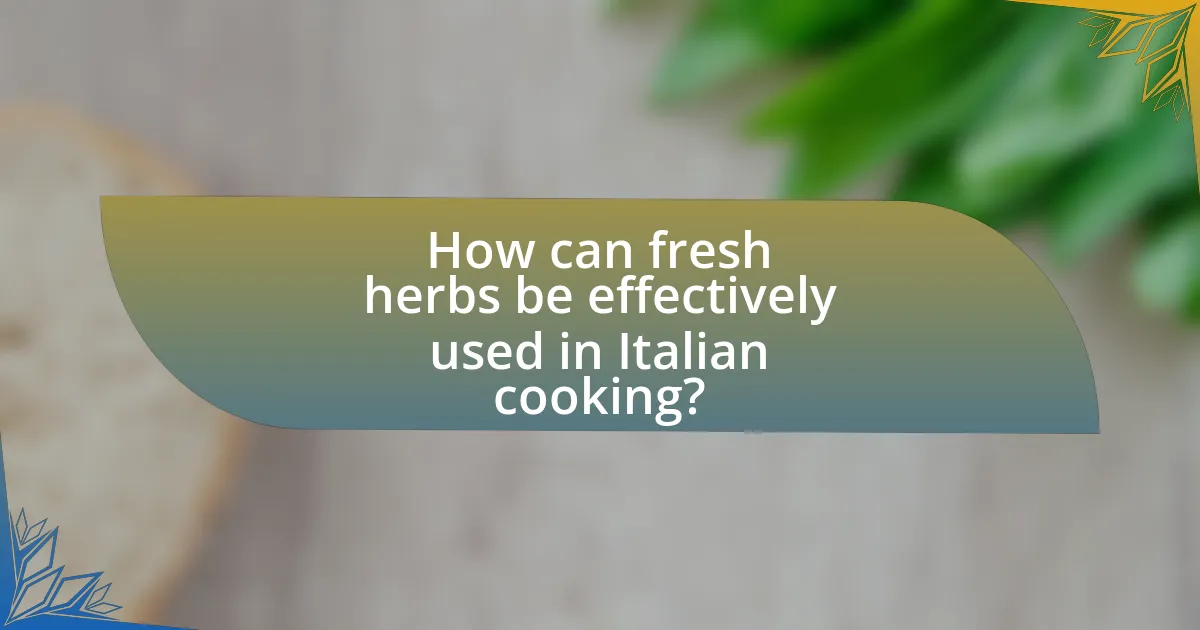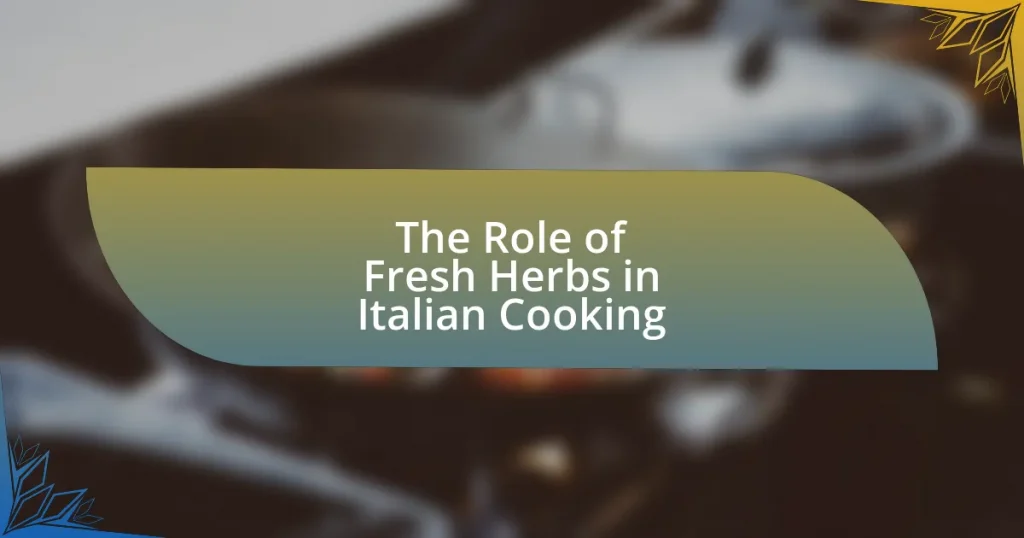Fresh herbs are essential in Italian cooking, significantly enhancing the flavor, aroma, and visual appeal of dishes. Key herbs such as basil, parsley, oregano, and rosemary are integral to traditional recipes, providing freshness and complexity that elevate the culinary experience. The article explores how fresh herbs enhance flavors, their cultural significance, and best practices for selecting, storing, and using them in various Italian dishes. It also highlights popular recipes that showcase the role of fresh herbs, emphasizing their importance in achieving authentic Italian flavors.

What is the role of fresh herbs in Italian cooking?
Fresh herbs play a crucial role in Italian cooking by enhancing flavor, aroma, and visual appeal of dishes. They are integral to traditional recipes, providing freshness and complexity that elevate the overall culinary experience. For instance, basil is essential in pesto and tomato sauces, while parsley is commonly used as a garnish and flavor enhancer in various dishes. The use of fresh herbs is rooted in Italian culinary tradition, where they are often added at the end of cooking to preserve their vibrant flavors and nutrients. This practice underscores the importance of fresh herbs in achieving authentic Italian flavors, making them indispensable in the cuisine.
How do fresh herbs enhance the flavor of Italian dishes?
Fresh herbs enhance the flavor of Italian dishes by adding vibrant, aromatic notes that elevate the overall taste profile. Herbs such as basil, oregano, and parsley contribute essential oils and compounds that create depth and complexity in sauces, marinades, and garnishes. For instance, fresh basil is a key ingredient in classic Italian dishes like Caprese salad and pesto, where its sweet and slightly peppery flavor complements tomatoes and cheese, enhancing their natural sweetness. Studies have shown that fresh herbs contain higher concentrations of flavor compounds compared to dried herbs, making them more effective in flavor enhancement. This is particularly evident in Italian cuisine, where the freshness of ingredients is paramount to achieving authentic taste.
What are the most commonly used fresh herbs in Italian cuisine?
The most commonly used fresh herbs in Italian cuisine are basil, parsley, oregano, and rosemary. Basil is essential in dishes like pesto and Caprese salad, while parsley is frequently used as a garnish and flavor enhancer in various recipes. Oregano is a key ingredient in sauces and pizza, and rosemary adds depth to roasted meats and vegetables. These herbs are integral to the flavor profile of Italian cooking, reflecting the country’s emphasis on fresh, aromatic ingredients.
How do different herbs complement various Italian ingredients?
Different herbs enhance various Italian ingredients by providing distinct flavors that elevate dishes. For example, basil complements tomatoes in sauces and salads, creating a classic pairing that balances sweetness and acidity. Oregano pairs well with meats and cheeses, particularly in pizza and pasta dishes, adding a robust, earthy flavor. Rosemary enhances roasted vegetables and meats, imparting a fragrant aroma and depth. Parsley serves as a fresh garnish that brightens rich dishes, while thyme works well with beans and stews, contributing a subtle earthiness. These combinations are rooted in traditional Italian cuisine, where the use of herbs is essential for achieving authentic flavors.
Why are fresh herbs preferred over dried herbs in Italian cooking?
Fresh herbs are preferred over dried herbs in Italian cooking because they provide a more vibrant flavor and aroma. The essential oils in fresh herbs are more potent than those in dried herbs, which can lose their intensity over time. For example, basil, a staple in Italian cuisine, has a fresh, sweet flavor that is essential for dishes like pesto and Caprese salad, where the herb’s freshness enhances the overall taste. Additionally, fresh herbs contribute to the visual appeal of dishes, adding color and texture that dried herbs cannot replicate.
What impact do fresh herbs have on the aroma of Italian dishes?
Fresh herbs significantly enhance the aroma of Italian dishes by introducing vibrant, aromatic compounds that elevate the overall sensory experience. Herbs such as basil, oregano, and parsley contain essential oils that release fragrant notes when heated or chopped, contributing to the dish’s complexity and freshness. For instance, basil’s sweet and peppery scent is a hallmark of classic Italian recipes like pesto and Caprese salad, while oregano’s earthy aroma is essential in tomato-based sauces. Studies have shown that the volatile compounds in fresh herbs can stimulate olfactory receptors, making the dishes more appealing and flavorful.
How does the freshness of herbs affect the overall dish quality?
The freshness of herbs significantly enhances the overall quality of a dish by providing vibrant flavors, aromas, and nutritional benefits. Fresh herbs contain essential oils and compounds that contribute to their intense flavor profiles, which can elevate the taste of Italian dishes such as pasta sauces and salads. Research indicates that fresh herbs can contain higher levels of antioxidants compared to dried herbs, which can improve the nutritional value of the meal. For example, a study published in the Journal of Agricultural and Food Chemistry found that fresh basil has higher antioxidant activity than its dried counterpart, reinforcing the importance of using fresh herbs for optimal dish quality.
What cultural significance do fresh herbs hold in Italian culinary traditions?
Fresh herbs are integral to Italian culinary traditions, symbolizing the connection between nature and food. They enhance flavors, elevate dishes, and reflect regional identities, with specific herbs like basil, parsley, and oregano being staples in various recipes. The use of fresh herbs is rooted in Italy’s agricultural practices, where local herbs are harvested and celebrated in seasonal cooking, showcasing the importance of freshness and locality in Italian cuisine. This cultural significance is evident in traditional dishes such as pesto, where basil is a key ingredient, highlighting the role of herbs in both flavor and cultural heritage.
How are fresh herbs incorporated into traditional Italian recipes?
Fresh herbs are incorporated into traditional Italian recipes primarily to enhance flavor and aroma. Commonly used herbs include basil, parsley, oregano, and rosemary, which are often added at various stages of cooking. For instance, basil is typically used fresh in sauces like pesto or added to dishes like Caprese salad, while oregano is frequently included in tomato sauces and pizza. The use of fresh herbs not only contributes to the dish’s taste but also reflects the Italian culinary emphasis on using high-quality, fresh ingredients. Historical practices in Italian cooking highlight the importance of herbs, as they have been cultivated in Italy for centuries, with regions like Liguria known for their basil and Tuscany for their rosemary.
What regional variations exist in the use of fresh herbs across Italy?
Regional variations in the use of fresh herbs across Italy are significant, reflecting local climates, traditions, and culinary practices. In Liguria, basil is predominant, especially in pesto, while in Tuscany, rosemary and sage are commonly used in meat dishes. The southern regions, such as Calabria and Sicily, favor oregano and parsley, often incorporating them into sauces and seafood dishes. In contrast, the northern regions, like Trentino-Alto Adige, utilize herbs such as chives and dill, influenced by Austrian cuisine. These variations highlight the diverse culinary landscape of Italy, where fresh herbs play a crucial role in enhancing flavors and regional identity.

How can fresh herbs be effectively used in Italian cooking?
Fresh herbs can be effectively used in Italian cooking by incorporating them into sauces, marinades, and as garnishes to enhance flavor and aroma. For example, basil is a key ingredient in pesto and Caprese salad, while parsley is often used in gremolata to complement dishes like osso buco. Additionally, herbs such as oregano and thyme are essential in tomato-based sauces, providing depth and complexity. The use of fresh herbs not only elevates the taste but also adds vibrant color and nutritional benefits, as they are rich in antioxidants and vitamins.
What are the best practices for selecting fresh herbs?
To select fresh herbs effectively, prioritize vibrant color, strong aroma, and firm texture. Fresh herbs should appear bright and lively, indicating they are recently harvested. A strong, pleasant aroma signifies freshness and potency, essential for enhancing flavors in Italian cooking. Additionally, the texture should be crisp and not wilted or slimy, as this indicates quality. Research shows that fresh herbs lose flavor and nutrients quickly, so selecting those with these characteristics ensures maximum taste and health benefits.
How can one identify high-quality fresh herbs at the market?
To identify high-quality fresh herbs at the market, look for vibrant color, strong aroma, and firm texture. Fresh herbs should display rich, deep colors without any yellowing or browning, indicating they are healthy and recently harvested. A strong, pleasant aroma signifies freshness and potency, as essential oils are more concentrated in high-quality herbs. Additionally, the texture should be crisp and firm; wilted or limp leaves suggest age and loss of quality. These characteristics are essential for ensuring the herbs will enhance the flavors in Italian cooking effectively.
What storage methods help maintain the freshness of herbs?
To maintain the freshness of herbs, refrigeration in a damp paper towel or a sealed container is effective. This method helps to retain moisture while preventing wilting, as herbs can lose their freshness quickly when exposed to air. Additionally, storing herbs upright in a glass of water, similar to a bouquet, can prolong their life by keeping the stems hydrated. Research indicates that proper storage can extend the shelf life of herbs by several days, ensuring they remain vibrant and flavorful for culinary use.
How should fresh herbs be prepared for cooking?
Fresh herbs should be washed, dried, and chopped or torn before cooking. Washing removes dirt and pesticides, while drying prevents excess moisture that can dilute flavors. Chopping or tearing releases essential oils, enhancing the aroma and taste in dishes. For example, basil and parsley are commonly used in Italian cooking, where their flavors are intensified when prepared this way.
What techniques are best for chopping and mincing herbs?
The best techniques for chopping and mincing herbs include using a sharp knife for precision and employing a rocking motion to achieve uniformity. A sharp knife minimizes bruising, preserving the herbs’ essential oils and flavors, which is crucial in Italian cooking where fresh herbs play a significant role. Additionally, using a mezzaluna, a curved knife, allows for efficient mincing by rocking back and forth, which can be particularly effective for herbs like basil and parsley. These methods ensure that the herbs are finely chopped, enhancing their flavor release when incorporated into dishes.
How can herbs be infused into oils or sauces for enhanced flavor?
Herbs can be infused into oils or sauces by gently heating the herbs in the oil or sauce to extract their flavors. This process typically involves combining fresh or dried herbs with a neutral oil, such as olive oil, and heating them over low heat for a specified duration, usually 10 to 30 minutes, allowing the essential oils and flavors to meld. For sauces, herbs can be added during the cooking process, allowing their flavors to integrate fully as the sauce simmers. Studies show that heating herbs can enhance the release of aromatic compounds, making the infusion more flavorful.
What are some common mistakes to avoid when using fresh herbs?
Common mistakes to avoid when using fresh herbs include using dried herbs instead of fresh, which diminishes flavor, and adding herbs too early in the cooking process, leading to loss of aroma and potency. Additionally, not washing herbs properly can introduce dirt and pesticides, while chopping them too finely can release excessive oils, resulting in a bitter taste. Lastly, storing fresh herbs improperly, such as in a sealed container without air circulation, can cause them to wilt and lose their freshness. These practices can significantly impact the quality and flavor of dishes in Italian cooking, where fresh herbs are essential for authentic taste.
How can overuse of herbs negatively impact a dish?
Overuse of herbs can overwhelm a dish, leading to an unbalanced flavor profile. When excessive amounts of herbs are added, they can dominate the taste, masking the dish’s primary ingredients and creating a muddled flavor experience. For instance, in Italian cooking, where the harmony of flavors is essential, too much basil or oregano can overshadow the subtle notes of tomatoes or garlic, resulting in a dish that lacks depth and complexity. This imbalance can detract from the intended culinary experience, making the dish less enjoyable.
What are the signs of herbs that have gone bad?
Herbs that have gone bad exhibit several clear signs. These signs include wilting or drooping leaves, discoloration such as yellowing or browning, and a slimy texture, which indicates spoilage. Additionally, a foul or off odor can be present, signaling that the herbs are no longer fresh. These indicators are essential for identifying herbs that are unsuitable for culinary use, particularly in Italian cooking where freshness is crucial for flavor.

What are some popular Italian dishes that highlight fresh herbs?
Popular Italian dishes that highlight fresh herbs include Caprese salad, pesto alla Genovese, and bruschetta. Caprese salad features fresh basil, mozzarella, and tomatoes, showcasing the herb’s aromatic qualities. Pesto alla Genovese, made primarily with fresh basil, pine nuts, garlic, and olive oil, is a staple sauce in Italian cuisine, emphasizing the herb’s vibrant flavor. Bruschetta, often topped with a mixture of tomatoes, garlic, and basil, highlights the freshness of the herbs, enhancing the overall taste of the dish. These dishes exemplify the integral role fresh herbs play in Italian cooking, enhancing flavors and providing aromatic depth.
Which pasta dishes benefit from the addition of fresh herbs?
Pasta dishes that benefit from the addition of fresh herbs include pesto pasta, spaghetti aglio e olio, and fettuccine alfredo. Pesto pasta, which traditionally uses basil, gains enhanced flavor and aroma from fresh herbs, making it a vibrant dish. Spaghetti aglio e olio, typically featuring garlic and olive oil, is elevated by the addition of parsley, which adds freshness and color. Fettuccine alfredo, a creamy dish, can be complemented by fresh chives or thyme, providing a subtle herbal note that balances the richness. These examples illustrate how fresh herbs can significantly enhance the taste and presentation of various pasta dishes.
How do fresh herbs elevate the flavor profile of pesto?
Fresh herbs elevate the flavor profile of pesto by adding vibrant, aromatic notes that enhance its overall taste. The primary herb used in traditional pesto is basil, which contributes a sweet, peppery flavor and a fragrant aroma, making the sauce more complex and appealing. Additionally, the essential oils in fresh herbs release volatile compounds that provide freshness and brightness, distinguishing homemade pesto from store-bought versions. Studies have shown that fresh herbs contain higher concentrations of flavor compounds compared to dried herbs, further validating their role in enhancing culinary dishes like pesto.
What role do herbs play in classic sauces like marinara and arrabbiata?
Herbs play a crucial role in classic sauces like marinara and arrabbiata by enhancing flavor, aroma, and overall complexity. In marinara, herbs such as basil and oregano contribute to its signature taste, providing a fresh and aromatic profile that complements the tomatoes. Similarly, arrabbiata sauce utilizes herbs like parsley and red pepper flakes to add depth and a spicy kick, elevating the sauce’s character. The use of these herbs is rooted in traditional Italian cooking, where fresh ingredients are essential for achieving authentic flavors.
What are some traditional Italian salads that feature fresh herbs?
Traditional Italian salads that feature fresh herbs include Caprese salad, which consists of fresh mozzarella, tomatoes, basil, and olive oil; Panzanella, a Tuscan bread salad with tomatoes, cucumbers, onions, and basil; and Insalata di Riso, a rice salad often made with fresh parsley, basil, and other vegetables. These salads highlight the use of fresh herbs, enhancing flavor and freshness, which is a hallmark of Italian cuisine.
How do fresh herbs enhance the freshness of Caprese salad?
Fresh herbs enhance the freshness of Caprese salad by adding vibrant flavors and aromatic qualities that complement the tomatoes and mozzarella. The inclusion of herbs like basil not only elevates the taste but also contributes to the overall sensory experience, making the salad more appealing. Research indicates that fresh basil contains essential oils that release fragrant compounds, which can enhance the perception of freshness in dishes. This aromatic quality, combined with the natural juiciness of ripe tomatoes and the creaminess of mozzarella, creates a harmonious balance that defines the Caprese salad.
What combinations of herbs work well in Italian vinaigrettes?
Basil, oregano, and parsley are effective combinations of herbs that work well in Italian vinaigrettes. These herbs complement each other, with basil providing a sweet, aromatic flavor, oregano adding a robust, earthy note, and parsley contributing freshness and brightness. This combination is commonly used in traditional Italian dressings, enhancing the overall flavor profile of salads and dishes.
What are some tips for incorporating fresh herbs into everyday Italian cooking?
To incorporate fresh herbs into everyday Italian cooking, use them to enhance flavor in sauces, marinades, and dressings. Fresh basil, for example, is essential in pesto and pairs well with tomatoes, while parsley adds brightness to dishes like pasta and risotto. Additionally, adding herbs at the end of cooking preserves their flavor and aroma, as heat can diminish their potency. Studies show that fresh herbs not only elevate taste but also provide health benefits, such as antioxidants and anti-inflammatory properties, making them a valuable addition to Italian cuisine.
How can home cooks experiment with herbs in their own recipes?
Home cooks can experiment with herbs in their recipes by incorporating different varieties, adjusting quantities, and combining them in unique ways. For instance, using fresh basil, oregano, and parsley can enhance the flavor profile of traditional Italian dishes, allowing cooks to discover new tastes. Research indicates that herbs not only add flavor but also provide health benefits, such as antioxidants and anti-inflammatory properties. By gradually increasing the amount of a specific herb or mixing complementary herbs, home cooks can tailor their dishes to personal preferences while exploring the diverse culinary possibilities that fresh herbs offer.
What are some simple herb-based recipes for beginners in Italian cooking?
Some simple herb-based recipes for beginners in Italian cooking include Caprese Salad, Pesto Sauce, and Herb-Infused Olive Oil. Caprese Salad combines fresh mozzarella, tomatoes, and basil, drizzled with olive oil and balsamic vinegar, showcasing the flavor of basil, a staple herb in Italian cuisine. Pesto Sauce is made by blending fresh basil, garlic, pine nuts, Parmesan cheese, and olive oil, serving as a versatile sauce for pasta or sandwiches. Herb-Infused Olive Oil involves steeping fresh herbs like rosemary or thyme in olive oil, enhancing the oil’s flavor for use in dressings or marinades. These recipes highlight the essential role of fresh herbs in Italian cooking, providing both flavor and aroma.















